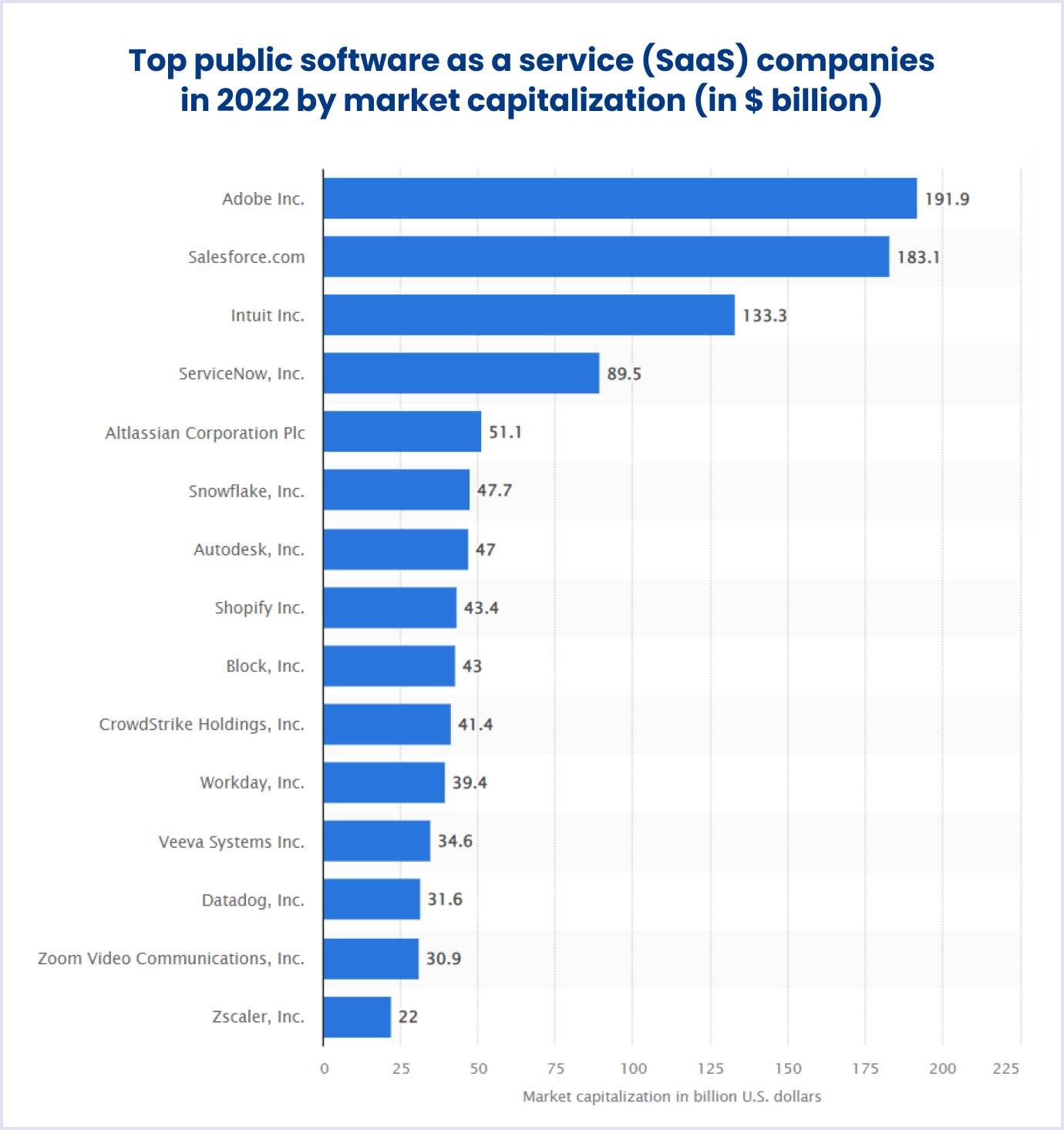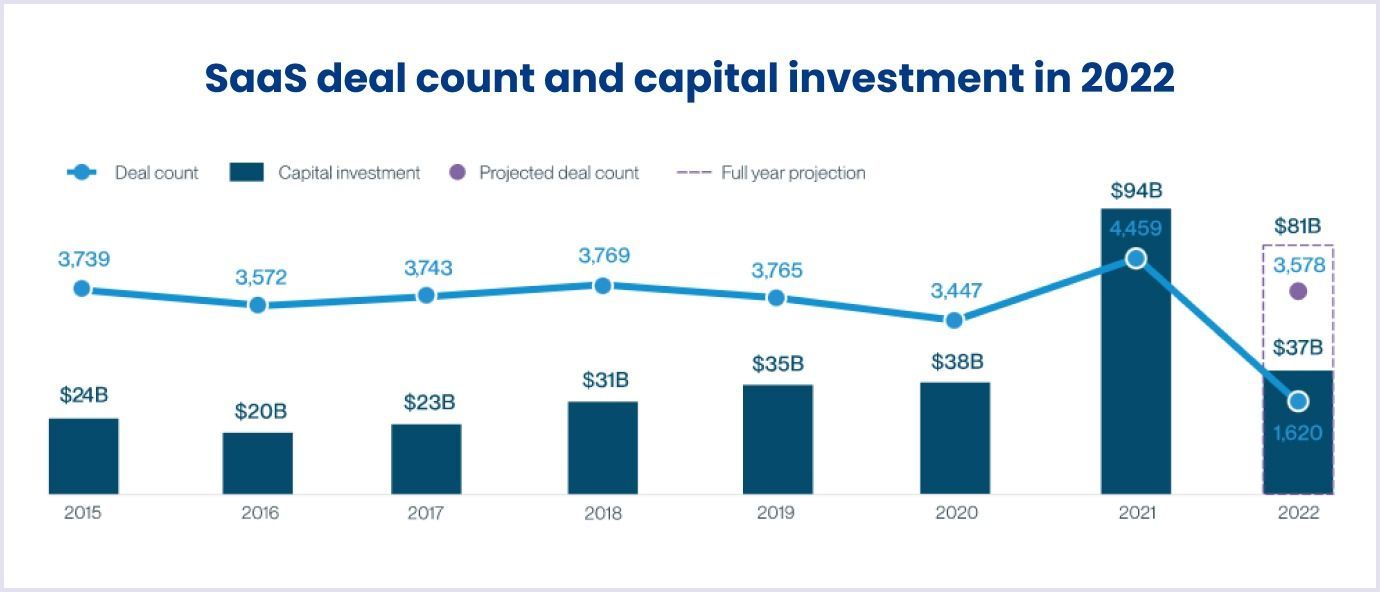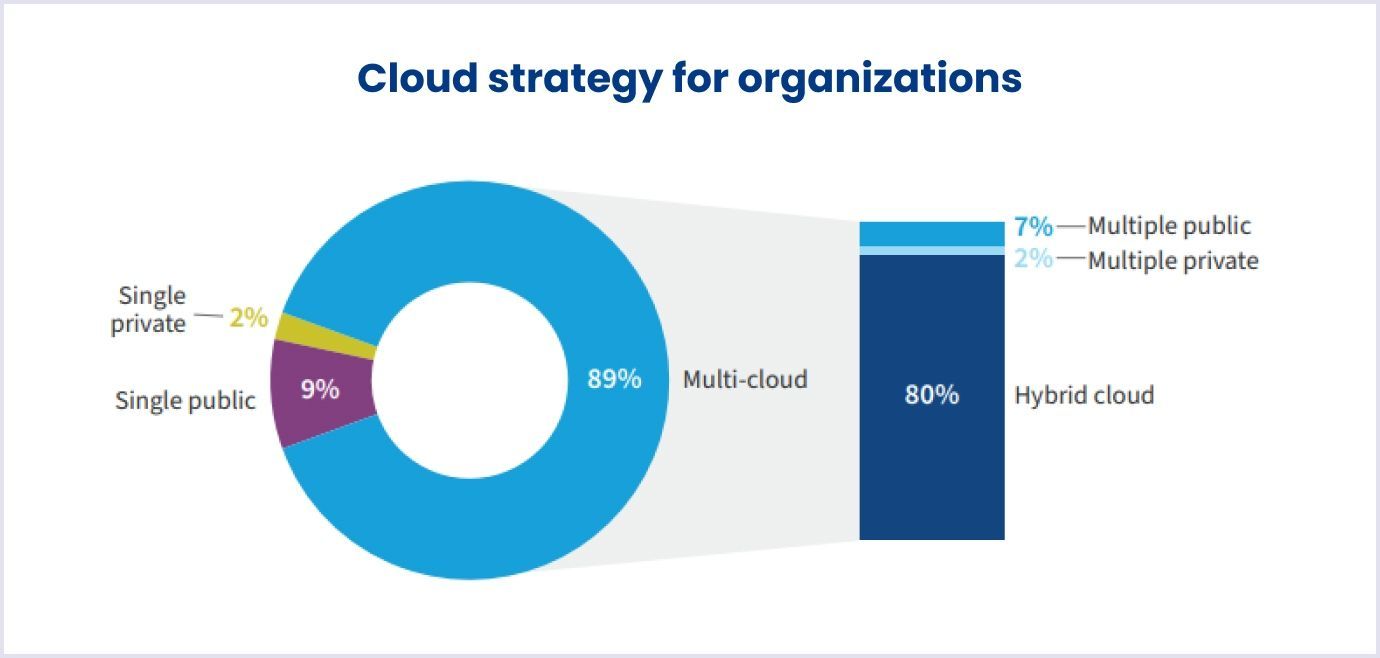The Future of SaaS: Top SaaS App Development Trends for 2023
Nowadays, different kinds of businesses are extensively moving to the cloud. Flexera’s report shows that 89% of the respondent companies use cloud services. In 2022, the software as a service (SaaS) market size value amounts to $242.57 billion and is expected to reach $356.6 billion by 2026. Therefore, SaaS application development looks also like a profitable venture today.
Saas industry trends
The year 2022 has brought significant changes in the global markets. The shifts also influence the cloud industry. So, below we consider how the cloud market changed in 2022 and what defines its trends for 2023.
SaaS trends among other cloud offerings
Over the past years, cloud computing has become a popular way to develop and run business applications. The rapid growth in cloud-based SaaS has led to the adoption of remote work which is the primary reason for its popularity. More than 80% of companies used cloud services in 2020 while only 35% of enterprises relied on traditional software licenses.

SaaS is rapidly growing and the service is already the largest cloud service in terms of spending. According to Gartner’s forecast, cloud end-user spending will reach $591.8 billion in 2023. SaaS growth in 2023 is predicted to be 16.8%
However, it is projected that the fastest-growing market with a compound annual growth rate (CAGR) of 20% over the following years will be IaaS.
SaaS industry trends and geopolitical impact
The SaaS industry saw unprecedented growth in investments and valuations in 2021 due to the increase in job openings. However, the pace slowed down as of June 2022 due to world geopolitical uncertainty. As you can see below, SaaS investments are projected to reach $81 billion by the end of the year. This is a decline compared with 2021 on an annual basis and is expected to remain so through 2022.

Source: Entrepreneur
The SaaS market is going through difficult times. The development of public companies, the growth in revenues and profit, and the falling valuation (in terms of price with a certain P/E ratio) are just some of the indicators that point to new challenges around. In this sense, investors have been cautious in this sector.
Cloud providers Box and Zendesk showed 16.9% and 17.0% YTD stock performance. Yet, the impact of geopolitical events was not only disturbing but also transformational. Cloud providers Box and Zendesk showed 15.1% and 17.3% YTD stock performance respectively, losing market share to competitors such as Amazon Web Services (AWS), IBM and Microsoft Azure in their respective industry segments.
SaaS adoption trends
Cloud computing is becoming more and more popular among businesses seeking better control over their IT operations, lower costs and increased productivity. However, there are differences in how companies are using cloud applications: some are using it to advance their business and others are using it just to save money.
According to Flexera report, during 2022, the fastest growth in cloud apps usage showed:
AWS
Microsoft Azure
Google Cloud
Also, Flexera reports that respondents tend to locate cloud apps in multi-cloud:
89% have a multi-cloud strategy
9% have a single public approach
2% use a single private cloud

Source: Flexera
As more and more organizations monetize the use of cloud services, the move to the public cloud is a top priority. The usage of cloud services continues at a steady pace, as half a million workloads are running in a public cloud already. The main result here is that respondents are prone to move sensitive data to the public cloud. Issues that impede moving data to the public cloud are app dependencies, technical feasibility, and costs.
SaaS app development trends
Multi-cloud strategy
According to the survey conducted by Microsoft, 90% of mid to large enterprises use a multi-cloud solution. Also, 81% of SMEs use multi-cloud solutions while 49% of SMEs adopt the multi-cloud approach. In 2022, software as a service company chose to spread its services across various providers. This approach is known as the multi-cloud strategy and promises to grow in 2023. It offers many pros, including flexibility and security in running business operations.
If you switch to multi-cloud services, your business is no more dependent on one cloud provider. This means the following advantages:
Cloud service cost optimization and switching to a different provider if costs are too high
Avoiding vendor lock-in and greater flexibility in changing providers if needed
Security and ability to move workloads to a public cloud or IaaS platforms in case of DDoS attacks
Flexibility in geographies and ability to move data to local providers or data centres.
Artificial intelligence
The artificial intelligence trend is predicted to take root in the future of SaaS. Yet, machine learning and natural language processing are already key trends in SaaS technologies. AI-powered technologies use the ability of human speech pattern recognition. Due to that, artificial intelligence enhances automation and security and speeds up data handling
The most demanded industries to adopt AI methods are social media, education, travel, and healthcare. The healthcare cloud computing market, as one of the most prospective fields, is forecasted to reach $51.9 billion by 2024.
Thus, to stay more responsive and flexible among others, be aware of AI, one of the high-level SaaS trends of 2023.
AWS AI Services is a key player in this area because it offers machine learning services for data scientists and developers. For example, the company has a Healthcare and Manufacturing uses case with Machine Learning Tools.
Low code/no code cloud services
Low code is one of the most influential SaaS trends you should follow in the development of SaaS apps. According to the survey, the low code market will reach $94.75 billion at a compound annual growth rate (CAGR) of 31.6%. Low code and no code tools help to quickly build and deploy projects that do not require complex architecture. Mostly they are used in web development and design. You can even build AI/ML-powered apps with low code/no code tools. So, low code is one of the most influential SaaS trends you should follow in the development of SaaS apps.
Low code/no code services can perform tasks that require less code on a computer. Examples of low-code platforms are Microsoft Power Apps, Mendix, Figma, Airtable, and Zoho Creator.
Such services can be used for creating simple business solutions. Therefore, this SaaS technology trend will likely evolve in 2023. Still, if you have a complex project or need a solution tailored to your business needs, it is advisable to opt for custom software development.
Vertical SaaS
As the tech industry becomes more sophisticated and vertical, it is important to understand what solutions your competitors are using. Traditional SaaS platforms only provide a snapshot of the market. The vertical approach will help you get closer to your customers and offer them the best practices in the field.
Vertical cloud SaaS is an ideal option for startups, SMBs and enterprises. With vertical SaaS, your customer acquisition costs drop drastically, since you can scale your operations up quickly. Furthermore, your competition in the cloud space will become even more difficult to topple.
Micro-SaaS
There are so many ways a SaaS product can be enhanced and customized to meet the needs of specific customers. A simple example would be a “box” around the basic functionality of a photo-sharing site, which would extend to offer audio and video capabilities.
Micro-SaaS models are easy to use, with a low budget and little knowledge required. This is because micro-SaaS projects require very small teams. They are also high-margin businesses and are often location-independent. Micro-SaaS is a great way to take advantage of cloud benefits, such as scalability and elasticity, while still being able to serve clients in your market.
Customer experience focus
SaaS industry overview shows that many SaaS platforms suffer from a lack of customer service. In 2023, it will become an important issue to solve many SaaS companies are striving to provide the most personalized solutions to customers to increase revenue and retain customers.
Furthermore, SaaS providers are increasingly focused on simplifying their services to retain customers. The ease of use is a big advantage, especially for small businesses.
So, to sum up, it is worth paying attention to customer experience as one of the Saas trends for 2023.
Enhanced security
The speed and depth of digital transformation not only provide business benefits but also create cyber risks. Cyber attacks continue to evolve and require high-level security to prevent them. The current industry offerings are proving insufficient to protect customers from the growing threat.
According to Gartner's forecast, spending on security risk management will grow 11.3% in 2023, reaching $188.3 billion. SaaS businesses will have to protect themselves and their customers from data leaks using targeted initiatives for improving their products' security. Developers will raise the bar of their products' security.
Security and compliance risks are the main barriers to realizing the benefits of the cloud. Security is a deciding factor in choosing a cloud partner. Hence, it is essential not to render your business vulnerable to cybercriminals and improve data protection.
White labelling
The growth of the SaaS trend has given rise to the development of many tools that allow startups to enter the market quickly, without having to spend time and resources developing their app.
So, what is white labelling in the cloud industry?
A supplier sells unbranded cloud solutions to agencies to put their branding and resell them at a profit. The key feature of white-label SaaS solutions is that they are fully customizable to look like it’s yours. The important thing is not just the look and feel of your solution, but also the functionality and ease of use that you can add to your app.
This model is known as a multi-feature provider model. In such a way, companies with different expertise can deliver the desired features for the customer. The benefit of this model is that it allows you to scale with little to no overhead costs. As a result, you can get higher revenue per client using this model.
Shaping the future of SaaS: Summary
The ever-changing nature of SaaS application development offers many opportunities for entrepreneurs. As technologies and customer demands are constantly changing, you need to know about the things happening in this field.
We find the biggest trends in cloud computing are focused on the future of SaaS (Software as a Service) and PaaS (Platform as a Service) in expanding small niche markets, while AI is focusing on shifting to PaaS and white-labelling trends lead to more complex and personalized cloud offerings coming into play.
While improving data security will be a necessary task in 2023 and beyond, it must be combined with a mobile-first mindset. Moreover, you must make your SaaS apps as customer experience-oriented as possible. Last but not least, a mobile-first mindset is a given while building cloud apps in 2023 and beyond.